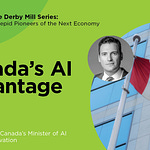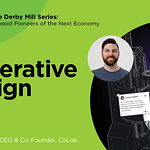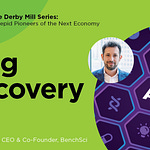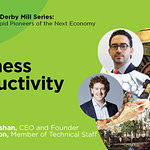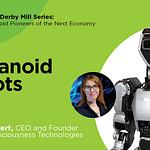Intrepid partner Ajay Agrawal and senior advisors Rich Sutton, Sendhil Mullainathan and Niamh Gavin are back to dig deep in this episode all about using artificial intelligence to increase the efficiency of mining exploration. That’s the act of using machine-learning techniques to analyze information from the earth, such as core samples, to decide multi-million-dollar questions, like where to build a mine or whether to expand an existing operation.
Our guests are CEO Grant Sanden and President of Resource Modelling Solutions Jared Deutsch from GeologicAI, a Calgary-based company that redefines geological and mining decision-making with advance core-scanning technology and AI-powered analytical and modelling solutions. From Sanden:
“You've got challenges in mining… You know, you're only touching a trillionth of the deposit… And it really is a structural problem in prediction… but then once you can deal with that well, you're now characterizing uncertainty. And with these new tools, we can plan through more robustly with uncertainty properly quantified, which is a challenging endeavour.”
And from President RMS Jared Deutsch:
“The application of AI and mining is so unique because we're so data-poor spatially, but so data rich, thanks to scanning and many other technologies, where we have millimetre-scale data. Challenge is, we're 100 meters away from our next millimetre scale data. So this makes for a very challenging problem in a very non-stationary environment, where no mineral deposit is like another one. And we can't really afford to sit around for a few 100 million years and wait to see how these things evolve. So it makes for a really fun and exciting application of AI, but a bit unique compared to other areas.”
EP 05 HOSTS
Ajay Agrawal, co-founder and partner, Intrepid Growth Partners
Richard Sutton, pioneer of reinforcement learning and professor, University of Alberta
Sendhil Mullainathan, MacArthur Genius grant recipient and professor, MIT
Niamh Gavin, Applied AI scientist, CEO, Emergent Platforms
LINKS
GeologicAI website and a short explainer video highlighting a GeologicAI use case.
GeologicAI CEO Grant Sanden LinkedIn
RMS President Jared Deutsch LinkedIn
Rich Sutton’s home page. Follow Rich on X
Sendhil Mullainathan’s website. Follow Sendhil on X
Be sure to catch every episode by subscribing on the following platforms:
YouTube // Spotify // Apple Podcasts
DISCUSSION POINTS
00:00 Introduction
01:23 Meet the GeologicAI team, and learn what the company does
04:22 Challenges and opportunities in mining data
05:41 Deutsch describes how unique mining exploration is as an AI application
06:53 Mullainathan asks about human-algorithm interaction
08:07 Sanden explains AI- and human-algorithm approaches
10:41 Gavin compares mining and healthcare as AI applications
12:23 Sutton on the way AI can create a super geologist
14:33 Sanden on the scale of GeologicAI’s operations
15:48 Mullainathan asks about optimizing the data collection
17:41 Agrawal on the extreme length of learning loops in mining
19:44 Mullainathan: Are there ways to reduce the 20-year lag?
25:13 The challenge of optimizing the data-collection cycle
27:24 Agrawal describes the mine of the future
30:08 The optimal path from limited loops to ultimate loops
31:00 Closing remarks
NUGGETS (short excerpts from the full episode)
NUGGET 01: Human-Algo Interaction
AIs learn from human feedback. Humans learn from AI predictions in edge cases. Sendhil Mullainathan and Grant Sanden discuss what this human-algorithm interaction might look like at the limit.
NUGGET 02: Super Geologists
AIs have the opportunity to learn from more core sample examples than any person. We know about the impact of adding more data to training sets to enhance performance. How accurately can we estimate the marginal benefit to adding a bit more data relative to the cost of collecting it? Rich Sutton questions whether we can imagine any geologist that will be better at mineral classification than the best AI.
NUGGET 03: Data Strategy
How does data collection via following the "natural order of things" differ from the optimal data collection strategy? A 20-year feedback loop seems crazy ("a little bit of a time lag"). Sendhil Mullainathan and Jared Deutsch discuss how to decrease the feedback loop.
NUGGET 04: A cheaper alternative to mining cores?
In the prior clip, we discussed the shifting value of core samples. In this case, Grant Sanden and Niamh Gavin consider other, much cheaper data sources (chips, dust, aerial imagery) that might also provide predictive power regarding hidden underground mineral deposits. Sendhil Mullainathan discusses how new forms of high-fidelity prediction that are orders of magnitude cheaper, although perhaps less accurate, might transform the fundamental economics of the mining industry.
DISCLAIMER
The content of this podcast is for informational and educational purposes only and should not be construed as marketing, solicitation, or an offer to buy or sell any securities or investments. The opinions expressed in this video are those of the participants and do not necessarily reflect the views of Intrepid Growth Partners or its affiliates. Any discussion of specific companies, technologies, or industries is for illustrative purposes and does not constitute investment advice. Viewers are encouraged to consult with their own financial, legal, and tax advisors before making any investment decisions.


